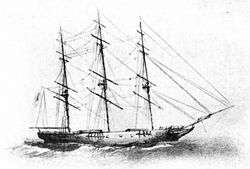Lammermuir (1864 clipper)
 Lammermuir built in 1864 | |
| History | |
|---|---|
| United Kingdom | |
| Namesake: | Lammermuir (1856 clipper) and the Lammermuir Hills |
| Launched: | 1864 |
| Out of service: | 1876 |
| Homeport: | London |
| Fate: | Lost at sea in 1876 |
| Notes: | Designed by W. Pile & Co of West Hartlepool |
| General characteristics | |
| Class and type: | Tea clipper |
| Length: | hull: 200 ft 4 in (61.06 m) |
| Beam: | 35 ft 5 in (10.80 m) |
| Draught: | 20 ft 9 in (6.32 m) |
| Propulsion: | Sails |
| Capacity: | 1,054 tons |
Lammermuir was an extreme composite clipper ship built in 1864 by W. Pile & Co of West Hartlepool for John "Jock" "White Hat" Willis & Son, London. She was the second ship to bear the name; the first Lammermuir had been the favorite ship of John Willis, and was wrecked in the Gaspar Strait in 1863.
She measured 200'4"×35'5"×20'9" and tonnage was 1054 NRT.
She was designed for the China tea trade. In 1866, she was almost wrecked in the East China Sea and the Pacific Ocean by two typhoons. She was under the command of Captain M. Bell and carried the famous Lammermuir Party of 18 missionaries and 4 children of the China Inland Mission outbound to China, arriving in Shanghai on 30 September 1866.
Hudson Taylor recalled the most perilous time in the voyage:
The appearance of things was now truly terrific. Rolling fearfully, the masts and yards hanging down were tearing our only sail... and battering like a ram against the main yard. The deck from forecastle to poop was one scarcely broken sea. The roar of the water, the clanging of chains, the beating of the dangling masts and yards, the sharp smack of the torn sails made it almost impossible to hear any orders that might be given.
In 1873 the Lammermuir left London, bound for Adelaide. Unfortunately, they left port without the all-important tool chest for the ship's carpenter. John Willis himself rushed to the docks to see to it that the Orient could take the chest along and deliver it to the ship. The captain of the Orient bet Willis that he would overtake the Lammermuir before it crossed the Equator to transfer the chest at sea, which he did.[1]
The clipper's last voyage was soon after this, from Adelaide to London on 10 November 1876, but she never arrived and was presumed to have been lost at sea.
Notes
- ↑ Lubbock (2005), 151
References
- Hudson Taylor & China’s Open Century Volume Four:: Survivors’ Pact; Alfred James Broomhall; Hodder and Stoughton and Overseas Missionary Fellowship, 1983
- Lubbock, Basil (2005). The Colonial Clippers. Kessinger Publishing. ISBN 1-4179-6416-2.
- Hudson Taylor and the China Inland Mission Chapter 6: Dr and Mrs Howard Taylor. Morgan and Scott 1918
